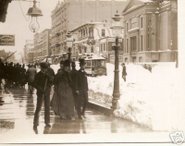Winter '18 / '19 - Sudden Stratospheric Warming: Watch #1 - UPDATE 3
From Judah Cohen's (AER) blog ...
"I have been arguing for at least a decade now that the winter season is shifting ahead in time so that it starts later and ends later. The fall months are warming across the NH (with one notable exception in Siberia) and that warming extends into December. However surprisingly the next three months, January through March are cooling across the NH mid-latitudes.
[...]
"The frequency of severe winter weather is increased following an SSW across the NH mid-latitudes including more Arctic outbreaks and heavy snowfalls. Therefore, temperatures are cooling for late winter starting in January and extending into March.
[...]
" ... if you are anticipating severe winter weather or a winter weather enthusiast the mild bland weather is necessary for a period of elevated risk of severe winter weather. Sure, there has been nothing memorable (at least for me; not true if you live in the Carolinas or Virginia) about December but the non-first half of winter is not independent of what I anticipate is a more active second half of winter.
[...]
"So, if you are a winter weather enthusiast, at least in my opinion the lack of winter so far is a necessary condition for cold and snow to follow. And if you like your winters mild then if the winter turns harsher in the near future it also was the cost for the benign winter so far.
[...]
" If the stratosphere and troposphere fail to couple, then I see no reason why the relatively benign winter weather can’t continue right up to spring.
[...]
"After the PV split the lowest heights and coldest temperatures are predicted to be in three regions in the stratosphere in Western Asia/Eastern Europe, the North Pacific and Southeastern Canada/Northeastern US. The models all agree that in the troposphere the lowest geopotential height anomalies will also be in Western Asia/Eastern Europe and the North Pacific with the models only disagreeing in Southeastern Canada/Northeastern US.
"But for the biggest impact the Arctic in the troposphere needs to warm up in my opinion and that has not happened. Also, the only region that is experiencing significant below normal sea ice extent is the Barents-Kara Seas. If the positive temperature anomalies remain confined to this region this is supportive of cold in Asia but not eastern North America.[...] In fact, low sea ice in the Barents-Kara Seas favor warm temperatures in the Eastern US based on this plot alone."
"I have been arguing for at least a decade now that the winter season is shifting ahead in time so that it starts later and ends later. The fall months are warming across the NH (with one notable exception in Siberia) and that warming extends into December. However surprisingly the next three months, January through March are cooling across the NH mid-latitudes.
[...]
"The frequency of severe winter weather is increased following an SSW across the NH mid-latitudes including more Arctic outbreaks and heavy snowfalls. Therefore, temperatures are cooling for late winter starting in January and extending into March.
[...]
" ... if you are anticipating severe winter weather or a winter weather enthusiast the mild bland weather is necessary for a period of elevated risk of severe winter weather. Sure, there has been nothing memorable (at least for me; not true if you live in the Carolinas or Virginia) about December but the non-first half of winter is not independent of what I anticipate is a more active second half of winter.
[...]
"So, if you are a winter weather enthusiast, at least in my opinion the lack of winter so far is a necessary condition for cold and snow to follow. And if you like your winters mild then if the winter turns harsher in the near future it also was the cost for the benign winter so far.
[...]
" If the stratosphere and troposphere fail to couple, then I see no reason why the relatively benign winter weather can’t continue right up to spring.
[...]
"After the PV split the lowest heights and coldest temperatures are predicted to be in three regions in the stratosphere in Western Asia/Eastern Europe, the North Pacific and Southeastern Canada/Northeastern US. The models all agree that in the troposphere the lowest geopotential height anomalies will also be in Western Asia/Eastern Europe and the North Pacific with the models only disagreeing in Southeastern Canada/Northeastern US.
"But for the biggest impact the Arctic in the troposphere needs to warm up in my opinion and that has not happened. Also, the only region that is experiencing significant below normal sea ice extent is the Barents-Kara Seas. If the positive temperature anomalies remain confined to this region this is supportive of cold in Asia but not eastern North America.[...] In fact, low sea ice in the Barents-Kara Seas favor warm temperatures in the Eastern US based on this plot alone."
























No comments:
Post a Comment